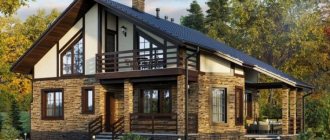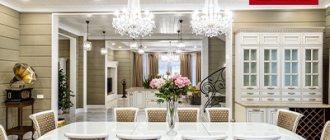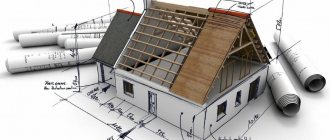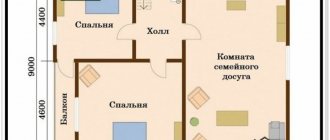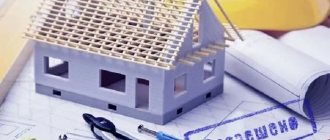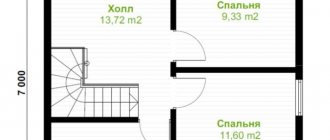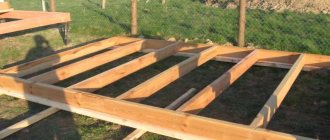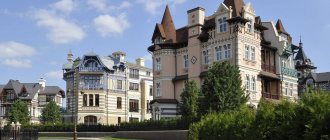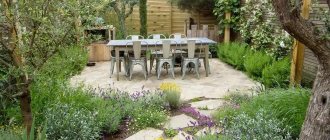A person learns all the “charm” of Italian urban planning by expressing a desire to build a country “house” on the territory of “Bell Pease,” as this country is often called, translated as “The Most Beautiful Country.” The buyer who agrees to a compromise with the seller of the site will have to “disentangle” the difficulties on his own, learning the rigidity of town planning legislation. What is the risk of illegal construction for the buyer?
Design features of Italian houses
The Italian style is a variation of the Mediterranean style, in which we can see a combination of baroque and country. The combination of such different areas of home design makes the Italian style special and unique. Italian style houses are noticeably different from other houses. The first thing you should pay attention to is the multi-level structure of the roof. The covering has a slight slope; the roof itself most often has a single-pitched, gable or cone-shaped shape. The roof does not stand out much from the background of the house. Its slope approaches the horizontal. The body of the house can be divided into several parts, which have a round or angular shape. Very often there are houses that are located in the letter “P”. In the center of such a house there is usually a fountain or statue.
Massive arches are used not only in interior design, but also in the design of the facade of a building. The arch can be located at the entrance or in the span between the buildings of the house. Thick columns are another sign of Italian style. They can be smooth or embossed. The windows in the Italian house are large, their shape rounded at the top repeats the design of the arch.
Italian children's room
Children in different countries, although they speak different languages, remain the same inside. It is important for a child that the room is bright and safe. It is better to avoid furniture with sharp corners, and cover the floor with a soft covering (carpet), although this does not quite correspond to the Italian style.
The set of furniture for the nursery depends on the age of the child and his character. For kids - this is a cozy, functional, often round playpen in light colors. Lots of shelves for toys and books. The play area is a rug with a cute pattern, bordered by a snow-white adjustable children's fence.
For teenagers, you need a large, comfortable bed with a soft headboard. For girls, this is, of course, pink, cream tones, and a four-poster bed. For boys - sea green, emerald. You also need to provide a study area: a desk and a chair. For active children, you can install a play wall. Frameless chairs look good in this interior.
Stylish children's room Source www.lacasa-m.ru
The Italian children's room is a combination of Baroque, Provence and minimalism. Children grow quickly, so you need to be especially responsible when choosing the size of children's furniture. Pay attention to products made from natural materials. An environmentally friendly nursery is not only safe, but also luxurious.
Curtains for the nursery Source shtory-devore.com.ua
If the room turns out to be a little boring and standard, you can always add a bright chandelier or, for example, photo curtains with a Venetian pattern or an ancient castle. For guys, you can look for curtains with cars or a sports pattern.
Room for a boy in a classic Italian style Source expertsamostroy.ru
Materials for building a house
Italian-style buildings are built using natural materials: stone, wood, marble, sandstone. The tiles that cover the roof are made from clay. The entire surface of the walls, stairs and floors is covered with stone of sedimentary and volcanic rocks.
Wood is used much less frequently than stone. The house's floors are made of massive logs, and almost all furniture is made of wood, preferably by hand.
From the ancient past and the Roman Empire, columns, frescoes and plaster stucco came into the Italian style. Relief paintings depict Mediterranean landscapes, lush gardens or scenes of historical significance.
Clay was previously used to create the tiles that cover the roof. Now this method seems inconvenient and impractical to us. To design the roof, you can use modern materials, which, on the one hand, will be as similar as possible to the material used by Italian craftsmen, and on the other hand, will be much stronger and more practical.
Services of leading specialists
Even with the most budget construction, you will have to hire at least three skilled workers in the following specialties:
- TB specialist.
- An architect who will supervise all work.
- Surveyor.
The larger the area of the future housing and the more complex the project, the more expensive the services of a surveyor and architect will cost. Typically, the costs for this expense item are 3% of the cost of the house.
Technical expenses are subject to VAT at the rate of 21% of the estimate.
Decoration of the facade of the house
The walls of an Italian-style house should be rough, made of stone, or smooth, with a perfectly smooth surface. Currently, there are several ways to create imitation stone luggage. The most convenient and common way is to use facade tiles with a stone texture. The second option is to create the desired surface relief using a thick layer of plaster. The imprint is made using special templates that are sold in hardware stores. With proper design and adding accents with paints, you will get a real house made of stone.
The smooth surface of the house is created by treating the surface with fine putty. After the putty has completely dried, you can begin sanding it. As a finishing layer, facade paint of a delicate ivory, beige, or pale brown color is used.
You can combine surfaces. Some parts of the building will be finished in the form of relief luggage, others will be covered with smooth plaster. This combination looks original and unusual.
Historical milestones in the development of laws in the field of construction
The establishment of a legislative framework cannot be called easy:
- in 1942, the first law regulating construction was issued.
- The year 1967 became a landmark year for the country in terms of building houses: a law was passed according to which all construction buildings were subject to obtaining a free (at that time!) Construction license. What made the owners of illegal buildings happy at that time? All buildings were recognized as legal.
- adjustments were made in 1977: you have to pay a fee to obtain a Construction License. The regulation is still in effect today.
Why is this attitude towards people who want to have their own home - the question arises? The secret is the lack of land in the required quantity suitable for construction. Since licenses are issued, then only to objects in full compliance with the coefficient of suitability for habitation, construction of a commercial or residential building.
Every municipality has a land plot plan. Using this database, the specialist prepares the project. The paper will need to be approved by the municipal authority, subsequently obtaining a construction permit. It is impossible to build a summer house on agricultural lands. There are some exceptions, but they only apply to farmers.
A dacha in the usual sense, as most compatriots understand it, is unrealistic in Italy.
Landscape design
Planning to build a house in the Italian style should also combine the development of a plan for the garden area. The first association when seeing an Italian theme is water. The organization of a reservoir, stream system or pond is carried out using a large number of stones. Water must be in motion; for this, a fountain is formed in the central part of the reservoir.
The entire surface of the ground should be covered with paving slabs that imitate stone. Only small areas of soil can be occupied by a lawn or neatly trimmed shrubs. The organization of tiers is encouraged. Stairs and paths made of stone, as well as stone walls and rises with a transition system are the most striking signs of the Italian style.
The area in the garden can be decorated with statues depicting heroes of Antiquity. Niches in the massive walls are decorated with sculpture.
Lighting
On the one hand, residents of southern countries are accustomed to bright natural light, on the other hand, this is why they are not drawn to lighting their homes too brightly, especially since there are no very long nights here. That is why the main chandelier, no matter how lush and huge it may seem, in an Italian-style room never gives off too much light, but shines softly and diffusely.
Of course, for certain needs, good lighting is still necessary, but this issue is solved by lamps that provide spot light.
Most often these are small wall sconces, leaving the center of the room in light twilight. According to the logic described above, the modern branch of the Italian style is very drawn to various stretch and suspended ceilings - they allow you to build in spotlights and not take up space near the wall.
One-story house project
It is better to entrust the design of a house in the Italian style to a specialist. Only a competent architect will be able to draw up a detailed plan of a building that meets all norms and standards. The design of an Italian house must include detailed documentation for each stage of construction. The designer must choose the optimal way to organize the foundation, taking into account the heavy loads of the house and the characteristics of the soil.
The choice of project depends on the number of future residents and the financial capabilities of the family. The Italian style involves the use of a large space, so if you have a modest construction budget, it is better to choose a different style of building design. Even a one-story Italian house will require a large area and funds for construction.
At the design stage, the materials that will be used during construction must be selected. A detailed layout diagram of sewerage, water supply, and ventilation networks is drawn up.
How much does it cost to build a house in Italy in 2021?
0
Leave a plus!
We will tell you how much it will cost to build a house in Italy and what expenses should be taken into account first of all.
Building a house in Italy is an expensive and very complex process.
The total construction costs will be determined based on the type of house, the building materials used, the cost of the work, the complexity and volume of preparatory work, the composition of the design documentation and many other reasons.
Based on a real example taken from a construction project, let's look at all the main costs of building a home in Italy.
When talking about home construction prices, experts refer to prices per square meter, including taxes and licensing costs added to the final amount.
The final estimate is divided into the main cost items required to carry out the work.
First, let's look at the approximate structure of the total costs of building a turnkey house in Italy:
- excavation;
- electrical wiring;
- laying the water supply system;
- installation of thermal equipment;
- connections to the electrical network, water supply, gas network;
- installation of thermal insulation.
Estimate of total costs for building a house
This estimate is very variable and depends on factors such as the area of the house being built, the quality of materials and finishes, the complexity of the construction work, the cost of the construction company’s services, etc.
An approximate estimate for a single-family house is 750-900 € per m2 (for luxury housing and building a house in a difficult topographical area, the price will increase).
Costs when contacting a developer company
If you contact a construction company to build housing in Italy, its employees will take care of everything necessary, but the cost per square meter of real estate will increase by approximately 19% of the estimated value.
The developer will handle everything from building the foundation to installing doors, windows, antennas and even sockets.
Technical costs for housing construction
Technical costs fall into three main categories:
Development site survey
1. Topographical study: outlines the exact geometry of the site on which the house will be built.
The cost of a topographical survey is about 250-400 euros, depending on the situation and area of the site.
2. Geotechnical Study: It determines the characteristics of the terrain and serves to design adequate foundations. Its price is usually around 650-800 €.
Expenses for the development of project documentation
The cost of an architect's services when drawing up a basic and executive project varies depending on two factors: the complexity and area of the living space.
The amount is usually about 4-6% of the total cost of building a house.
Labor costs for leading specialists
To build housing, you will need to pay for the services of at least three qualified specialists:
- work manager (architect);
- design technician, surveyor);
- safety specialist.
The workload of the architect and surveyor, and therefore the cost of their services, depends on the complexity of the project and the area of housing; the services of each of them will cost approximately 2-3% of the total estimated cost of housing under construction.
VAT, which applies to technical costs, is 21% of the estimate.
Municipal license for housing construction
When building new housing in Italy we are faced with two types of taxes, which vary depending on the individual municipality.
A building permit is issued after monitoring the compatibility of the project with the town planning standards contained in municipal legislation.
Its cost is about 1-2% of the cost of housing under construction.
Tax on construction work
This is a tax on construction work, payment of which is necessary to begin it (about 4% of the total costs of building a house).
Registration in the real estate register
After the work is completed, the new building must be registered in the Real Estate Register.
Notary fees and registration costs are determined by law. The sum of both is about 0.5% of the value of the property.
Tax on new buildings (for putting housing into operation)
Next, the municipal authorities verify that the work performed corresponds to the design submitted during the application process for a building license.
If the final cost of the project has changed, adjustments may be made to increase or decrease this tax.
Connecting the water supply and sewerage system, heating and power supply systems
For each connection you will have to pay, on average, about 200 euros.
Cleaning after major construction work, repairs and finishing
Costs can be, on average, 10% of the original estimate.
Example of costs for the construction of a single-family dwelling (area: 120 m2)
| Construction materials costs | (€ 800/m2) € 96,000 |
| Total cost of the contract with the developer | (€ 952 / m2) € 114,252 |
| Total with VAT (10%) | € 125,664 |
| The cost of topographic studies of a building site | 1100 € |
| Expenses for the development of project documentation (5%) | € 4800 |
| Labor costs for leading specialists (2%) | 1882 € |
| Total with VAT (21%) | 9416 € |
| Cost of construction license (1.5%) | € 1418 |
| Tax on new buildings (4%) | € 3692 |
| Connecting water supply, heating and electricity systems | € 500 |
| TOTAL | 140,690 € |
| Cost item | Price |
To all these costs you must add the cost of land, property transfer tax, mortgage finance costs, notary services, the cost of finishing and furnishing a new home. Therefore, another 20-30% should be added to the above amount.
Thus, answering the question “How much does it cost to build a house in Italy in 2021?”, we can conclude that the estimated cost of building a single-family home with an area of 120 m2 is 168,000 euros.
Building a house in Italy: possible options
Construction of frame houses
Frame houses are an interesting option when you need to build a house without delaying or complicating the process.
The main advantage of this type of construction is that the price of such housing is approximately 30% lower.
As a guide, prices for modern frame houses start from €112,000 (including VAT) for a home of approximately 85 square m2
Construction of cottages
These homes are for those who prefer more classic, timeless designs.
The average price for building village houses is around 150,000 euros for houses with an area of 100 sq.m.
Construction of ecological houses
When building green houses, materials such as wood or glass are used to minimize the impact on the environment.
The average cost to build eco-houses is around €150,000 for a property with an area of 80 sq.m.
Tax benefits for building your first home
The 2021 Budget Law provides for tax incentives associated with the construction of a first home. However, to take advantage of this benefit, the property must be the owner's primary residence and the owner of the land on which the building is built.
If these conditions are met, you can receive a 4% reduction in the VAT rate on purchased finished construction products, costs necessary to carry out the work, and also, possibly, finishing repair work.
Moreover, if the owner took out a loan to build his first home, he can take advantage of a 19% deduction on all expenses incurred during the tax year.
https://liveitaly.ru/info/skolko-stoit-pos...
- Immigration to Italy
Interior design in Italian style
The space inside an Italian house needs to be designed in such a way that it is as comfortable and themed as possible. Italian notes should be felt in every room of the house.
When finishing walls, a monolithic coating is created. To do this, you can use putty, which is painted with paint. In some places you can make accents - create areas that imitate stonework. Gypsum-based tiles can achieve this effect.
The floor in the house can be laid with tiles that imitate marble or stone. The chosen colors should be in harmony. The best color scheme is to use shades of beige and brown tones. In some cases, a combination of snow-white coatings and bright blue accents is used. It all depends on the direction of the Italian style. If you want to get closer to the Mediterranean theme, then choose light bright colors, if you are closer to the luxurious baroque style, then warm shades are suitable.
Legitimize a built house - myths and reality
A person has the right to attach a building to legal homes by applying to the Construction Amnesty, regulated by national legislation. To resolve the issue of the legality of structures, 3 legal acts were issued. The last one was published in 2003. One of them, “Piano Casa” from the Berlusconi government even provides for the possibility of expanding square meters.
Certain objects are not subject to amnesty. You can find out about the application deadlines and the amount of sanction fees from the municipality. They differ depending on the territory of the state. To obtain approval for an amnesty, you must obtain municipal permission for it.
Kitchen interier
An Italian-style kitchen looks ambiguous: on the one hand there may be antique pieces of ancient furniture, on the other - modern furniture that meets the latest trends in industrialization. Combination in interior design is a feature of the Italian style.
Above the dining table you can hang a large massive chandelier that imitates a candlestick. The light should be warm and diffused. For a white kitchen, the cool white light of bright lamps that hang from the ceiling is used.
All kitchen furniture must be made of solid wood. You can use an imitation of solid wood using a variety of building materials. An Italian-style kitchen hood should stand out from the crowd. To decorate the hood, stucco molding is used in the form of volumetric curls and decorative elements characteristic of this style.
Features for small apartments
Italian style is quite easily adaptable to small apartments thanks to a whole set of elements that can change the visual geometry of the room. The high carved upper part of the door casing, coupled with a flat but wide ceiling plinth, will allow you to raise and expand the ceiling, adding air to the room. Compositions made from wall moldings are a universal means of playing with volume . Using wide or narrow, long or short rectangles in a pattern, you can correct the proportions of the room.
The rest of the set of rules can be considered common for the design of all small apartments:
- More light . The lack of natural light in the case of windows facing north can be compensated by good artificial light and the use of mirror surfaces in the interior.
- Bright hues . Light walls, floors and furniture can make even a small room visually spacious.
- Less furniture . For a small apartment, it is preferable to use only the necessary minimum of furniture, abandoning extra shelves, tables, consoles and other things. Moreover, it is better to choose pieces of furniture with a transformable function that can free up space when folded.
Bedroom interior
Italian bedrooms are distinguished by their luxury and sophistication. Mostly pastel colors are used for decoration. The most common shades for wall decoration are beige and ivory.
To make a bedroom set, it is better to use wood species such as oak or pine. It is better to coat the surface of the wood with varnish; you can use stain. You can also use wood to cover the floor, but it is better to give preference to marble or tiles that imitate stone.
The design of the bed is characterized by its bulkiness and volume. Options for making beds from wood or metal are allowed. Forged headboards, decorated in the form of original carvings, or soft edges of the bed, upholstered in expensive material, are the most obvious Italian notes in the design of the bedroom.
A mandatory attribute of an Italian bedroom are bedside tables, ottomans or coffee tables. All furniture must be made in the same style using the same materials.
Furniture
For aesthetically-oriented Italians, harsh chopped Nordic forms of furniture are something completely unacceptable. Southerners, on the contrary, love sophistication and smoothness in everything, which is why most furnishings contain light waves, curves and even patterns in their contours. If it is a table or a cabinet, then it should have small curved legs - it’s beautiful.
The inhabitants of Italy, by nature, are not accustomed to any harsh tests, so they look for comfort and convenience in everything. The predominant part of the furnishings fits the concept of upholstered furniture here - these are numerous sofas, armchairs and poufs.
Even the chairs at the dining table here should be soft and always have a high back - this is a matter of comfort.
Upholstered furniture upholstered in fabric, as well as bedroom sets, largely determine the color scheme of the room. We have already talked about what colors are welcome in Italian style, and textiles are selected according to the logic to be a bright accent against the background of the overall range.
Italians do not accept boring dullness, it puts pressure on them, and this rule is relevant not only in the nursery, but even in the usually strict (in our understanding) corridor.
Decor and accessories in Italian style
The walls in the house are decorated with objects characteristic of the times of Antiquity and the Renaissance. Figurines depicting ancient Roman gods, wall frescoes reflecting majestic historical events will undoubtedly decorate the room and create a unique atmosphere.
An Italian house can be decorated with various little things: hang classic-style curtains on the windows, place bottles filled with oils or cereals in the kitchen. Small figurines can decorate open shelves in niches, and in the spans between rooms it would be appropriate to install a large arch decorated with a relief pattern.
Decoupage technique is used to give furniture individuality. A paper-based pattern is glued to hard surfaces; after the paper has dried, the surface is treated with several layers of varnish. The good thing about this technique is that you can do it yourself with minimal expense, and the result will be amazing.
